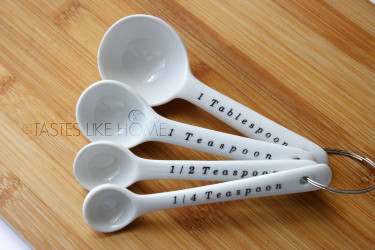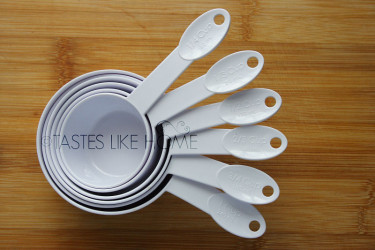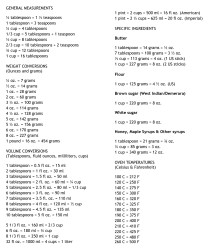Hi Everyone,
Picture this – you’ve just pulled out a recipe you had bookmarked or jotted down. You’re reading through the recipe to assemble the ingredients and you’ve come upon measurements in weight rather than volume, English versus American. Added to that, the recipe calls for ingredients that you may not have at hand but you do have other versions of the ingredients and you wonder if they can be used as substitutes. Sounds familiar? We’ve all been there.  Don’t fret. Print this column and stick it on to your refrigerator, cupboard or wall in your kitchen so that you can access the information easily and readily.
Don’t fret. Print this column and stick it on to your refrigerator, cupboard or wall in your kitchen so that you can access the information easily and readily.
There are certain things that need to be understood first.
All measuring cups and measuring spoons are not the same; some vary in volume.
Ingredients are packaged, labelled and sold differently from one country and region to another. For example, in some places you may be able to buy sticks of butter while in others, butter is sold in tubs or wrapped.
All-purpose flour is not created equal; some may have in more protein than others, some may be heavier while others are lighter.
Bread flour, pastry flour and cake flour are very different from all-purpose flour. These specialty flours have been modified to give maximum rise, crumb and texture when baked.
There are 2 ways to measure – by weight and by volume. Measuring by weight is more precise but not everyone has a scale and often measuring by volume is easier. Having said that, be guided by your recipe and the method of measuring with which you are most comfortable.
Being able to substitute one recipe item for another is an important skill for a home cook and I will try to dedicate more than one column to it. However, given that this is baking season, in this column I will focus on making substitutions when baking.

Cream – recipes calling for cream can be substituted with canned evaporated whole milk. However, you will need to add a few minutes to the cooking time. While the evaporated milk will add the necessary richness and creaminess, it is lighter (in volume) and will need the extra time to condense. Be guided by the recipe you are using and look for the visual cues of doneness provided.
Butter – recipes (sweet or savoury) will stipulate whether salted or unsalted butter is needed. There are 2 key things to note. Unsalted butter can be used in place of salted butter but you will need to add a little salt to the recipe in order to get the right flavour. The other thing to note is this – some salted butter is saltier than others. It is a good idea to taste the butter so that you can adjust any added salt that is needed for the recipe.
When baking sweet things and unsalted butter is called for and all you have is salted butter, omit whatever little salt is needed to balance the flavours. Most if not all sweet dishes call for a little salt to even out the flavours.
Salt – sea salt, kosher salt and fine table salt all contain the same amount of sodium by weight. However, they have differing levels of sodium by volume. The main difference between these types of salt is the size and shape of the crystals; therefore, if a recipe calls for ¼ teaspoon of fine table salt, it cannot be readily substituted with ¼ teaspoon sea salt because the salinity would not be the same. The fine table salt will add more sodium than the kosher salt. The best advice for salting is to taste your food and adjust to suit your taste.
White sugar – the two most common forms in which white sugar is sold are as regular granulated and as caster sugar. Caster sugar is the same white granulated sugar that has been ground to a very fine grain. Just like the salt, they contain the same degree of sweetness by weight. While it is okay to substitute caster sugar for regular white sugar in a recipe, it is not advisable to substitute white sugar for caster sugar, as you will be making the food sweeter.
If a recipe specifically calls for caster sugar, there is a reason, as it will have an effect how it will interact with the other ingredients, how it melts, and on the overall finished product. You can make your own caster sugar by grinding white sugar in a food processer; you will need a powerful one (processor) to do so.

Baking powder/baking soda – while both of these ingredients are leavening agents, they perform differently when added to other ingredients.
Baking soda is also labelled as sodium bicarbonate or bicarbonate sodium. When recipes stipulate baking soda, it requires moisture that contains some form of acid – yogurt, buttermilk, lime/lemon/orange juice etc. The acid is needed to eliminate the metallic taste of the baking soda while creating bubbles of carbon dioxide that expand causing baked goods to rise.
Baking powder contains baking soda and other ingredients – cream of tartar and starch. The cream of tartar in baking powder takes care of the acid that is needed for leavening and the starch is to keep it from caking.
You can substitute baking powder in place of baking soda (you will need more, and it may affect the taste) but you can’t substitute baking soda with a recipe that calls for baking powder.
All-purpose/self-rising flour – self rising flour is all-purpose flour that contains baking powder and salt. Some people prefer to use self-rising flour and eliminate the stress of working out how much baking powder to add to flour to make bakes, roti, cakes etc.
If a recipe specifically requests self-rising flour, it is because a certain degree of leavening is required along with sodium (salt) to interact with the other ingredients. Do not substitute self-rising flour for all-purpose flour. However, you can convert all-purpose flour into self-rising flour: take 1 cup all-purpose flour and add to it 1½ teaspoons baking powder and ¼ teaspoon fine table salt.
Conversions
Happy Cooking!
Cynthia










